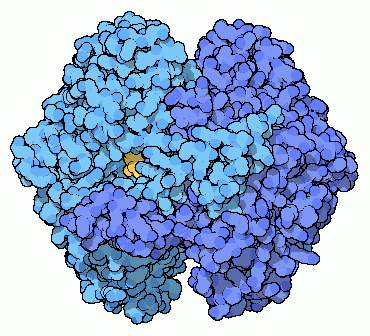|
Inhaltsübersicht | Nanomaschinen | Moleküle | Programme | Kurse | Fun | Links |
||
| > |
The Glycolytic Enzymes

Phosphoglucose Isomerase
The second step in glycolysis is an isomerization: a reaction that changes the shape of a single molecule, but doesn't permanently add or remove any atoms. The enzyme phosphoglucose isomerase, shown here from PDB entry 1hox, takes glucose-6-phosphate and shuffles a few atoms, forming fructose-6-phosphate, shown here in yellow. The enzyme can do this reaction in either direction. So when glucose-6-phosphate is plentiful in the cell, it converts it to fructose-6-phosphate, and when fructose-6-phosphate is more common, the enzyme converts it back.Recently, researchers have discovered that this protein also plays other important roles outside of cells, acting not as an enzyme but rather as a molecular messenger. It is secreted by white blood cells and helps control the growth and motion of many types of cells. As researchers delve deeper and deeper into the human genome, they are discovering numerous examples of other "moonlighting" proteins that have one function in one place in the body and an entirely different function somewhere else.
Next: 3: Phosphofructokinase
Previous: 1: Hexokinase
Last changed by: A.Honegger,